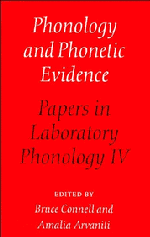Book contents
- Frontmatter
- Contents
- List of contributors
- Acknowledgments
- 1 Introduction
- I Features and Perception
- II Prosody
- 8 Stress shift: do speakers do it or do listeners hear it?
- 9 The phonology and phonetics of the Rhythm Rule
- 10 The importance of phonological transcription in empirical approaches to “stress shift” versus “early accent”: comments on Grabe and Warren, and Vogel, Bunnell, and Hoskins
- 11 Perceptual evidence for the mora in Japanese
- 12 On blending and the mora: comments on Kubozono
- 13 Toward a theory of phonological and phonetic timing: evidence from Bantu
- 14 On phonetic evidence for the phonological mora: comments on Hubbard
- III Articulatory Organization
- Subject index
- Index of names
- Index of languages
12 - On blending and the mora: comments on Kubozono
Published online by Cambridge University Press: 03 May 2011
- Frontmatter
- Contents
- List of contributors
- Acknowledgments
- 1 Introduction
- I Features and Perception
- II Prosody
- 8 Stress shift: do speakers do it or do listeners hear it?
- 9 The phonology and phonetics of the Rhythm Rule
- 10 The importance of phonological transcription in empirical approaches to “stress shift” versus “early accent”: comments on Grabe and Warren, and Vogel, Bunnell, and Hoskins
- 11 Perceptual evidence for the mora in Japanese
- 12 On blending and the mora: comments on Kubozono
- 13 Toward a theory of phonological and phonetic timing: evidence from Bantu
- 14 On phonetic evidence for the phonological mora: comments on Hubbard
- III Articulatory Organization
- Subject index
- Index of names
- Index of languages
Summary
Introduction
In his paper, Kubozono nicely summarizes the literature on the mora as a salient unit in speech production in Japanese, and then describes new results which he takes as evidence for the mora as a comparably salient unit in speech perception. His experiments presented pairs of English CVC monosyllables, such as hill and top, to which subjects responded with a third word blending the two stimulus words. Responses differed for different subject groups; English speakers combined the onset of the first word with the rhyme of the second (hill + top = hop), whereas Japanese speakers usually took both the onset and the nucleus from the first word and only the coda consonant from the second (hill + top = hip). Pilot results for two Italian and nine Spanish speakers also showed the Japanese pattern.
Kubozono interprets these results as indicating a difference in syllable-internal prosodic structure among the languages, illustrated in (la) for English and (lb) for the other three, (lc) is Derwing, Yoon & Cho's (1993) alternative interpretation of the Japanese pattern of responses, which their Korean subjects also showed in a similar word-blend experiment. The difference between hypotheses (lb) and (lc) should not obscure the premise in common: Kubozono, like Derwing et al. (1993), takes the pattern of blends as evidence that speakers parse syllables exhaustively into some set of syllable-internal prosodic constituents which can differ from language to language.
- Type
- Chapter
- Information
- Phonology and Phonetic EvidencePapers in Laboratory Phonology IV, pp. 157 - 167Publisher: Cambridge University PressPrint publication year: 1995



